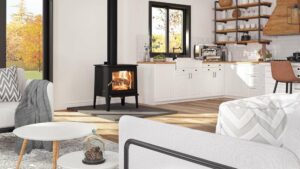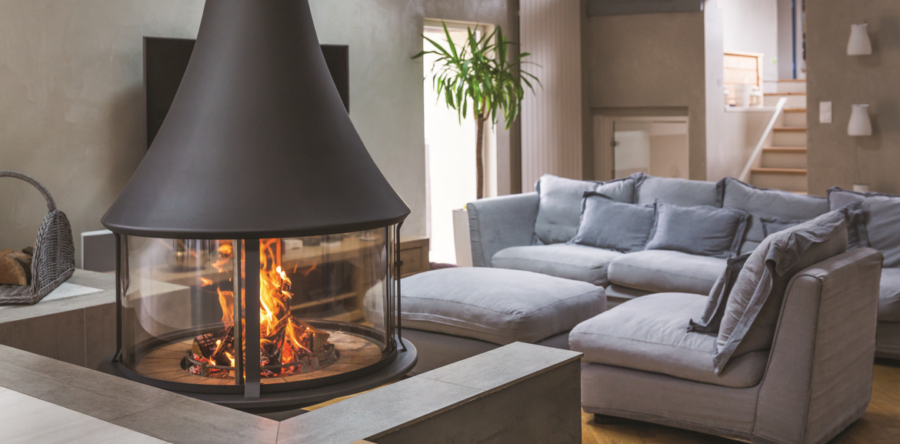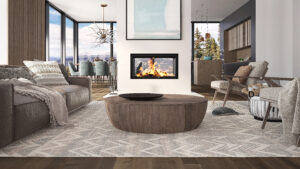Are you tired of those monthly gas or fuel oil bills? You want to be a bit more independent, right? You simply like the way wood heat feels and wonder, ‘Can a fireplace heat a whole house?’ If you’ve ever wished you could keep your entire home nice and warm by burning wood, it would be good to invest a few minutes and read this article.
EPA CERTIFIED OR OPEN BURNING?
Some fireplaces provide serious heat. Others do not. Some fireplaces heat for 8 to 10 hours. Some do not. Why is that?
Many wood-burning masonry and zero-clearance (ZC) fireplaces have little or no control over the amount of air going to the fire. A fireplace without doors is like a campfire in your living room. The fire burns beneath an 8″ or 10″ hole through your house. And guess where all that heat goes? Yup, right up the chimney!
Fireplaces with bifold doors are a bit better, but still not effective in controlling the fire’s combustion air or burn rate.
Sealed, gasketed doors on your fireplace, stove, or insert are your best option. These doors help provide long burn times by keeping air from slipping around the glass. A primary air control provides all air supplied to the fire necessary for combustion. A built-in blower fan also ensures most of the heat is delivered back into the room, not up the chimney.
This is one of the significant differences between an EPA (Environmental Protection Agency) certified appliance (CSA B415 in Canada) and one not qualified to carry the EPA tag. A wood-burning fireplace, stove, or insert must meet or exceed specific 2020 emission requirements set by the EPA’s New Source Pollution Standards (NSPS). Most certified equipment operates in the 70% + efficiency range.
It means 70% + of the generated heat warms your home instead of 90% or more lost up the chimney in a masonry fireplace!
There are no efficiency ratings with masonry or open-burning fireplaces. In fact, they likely operate at a negative efficiency. That is, they take more heat from the house than they contribute to it!
On the other hand, if it says “EPA 2020 certified,” you can count on burning wood much more efficiently and effectively. This will save you time and money and help protect our natural resources.

HEAT THE HOUSE!
So, can a wood-burning appliance heat the entire house? If you would like to heat your home with wood, don’t even consider using equipment that does not carry an EPA emissions tag. You’ll be wasting money and time by burning significantly more wood than necessary.
Your WE LOVE FIRE® dealer can show you several efficient, clean-burning, wood-fired equipment models.
WHAT SIZE WILL I NEED?
Many wood-burning fireplaces, stoves, and inserts can heat 2,000-3,000 square feet of well-insulated space. These are typically rated by BTU/output and by the firebox size in cubic feet. The larger the firebox, the more wood it will hold. Also, the longer the fire lasts, the more heat is produced.
Buyer beware! Most manufacturers state the ‘usable’ firebox size with insulating materials such as bricks, baffles, etc., but a few manufacturers state the firebox size without. This gives a false impression of the actual capacity since you should never use a unit without its insulating material. Bring the specifications of the models you are looking at to your WE LOVE FIRE® dealer, and they can sort out the actual numbers if necessary.
Depending on several variables, the following is a good rule of thumb:
- Small: less than 1.8 cubic feet heats up to 300 square meters (1000 square feet).
- Midsize: From 1.8 to 2.8 cubic feet, fireboxes produce 40,000 – 70,000 BTUs and should heat up to 600 square meters (2000 square feet).
- Large: Firebox sizes larger than 2.9 cubic feet produce over 70,000 BTUs depending on several variables and should heat up to 900 square meters (3000 square feet).
Please note the sizes above are for a well-insulated area.
Also, keep in mind that this is not an exact science. Note the words “up to” in the paragraph above. Many variables affect how quickly a house loses heat, such as:
- House age and layout
- Construction type
- Condition of windows and doors
- Air circulation
- Insulation
- House orientation
- Prevailing winds
- Temperate zone where you live
Since the square footage heating is entirely at the manufacturer’s discretion, you will see wide variations from one manufacturer to another. For example, manufacturer A’s 2 cubic foot firebox model claims 2,000 square foot coverage. Manufacturer B might claim 1,700 square foot coverage from a firebox of the same size. Once again, this is where your WE LOVE FIRE® expert can de-mystify those numbers. They can help you determine the best unit for your home.
Or, see our BTU Calculator to get a sense of how much heat you might need.
On the other hand, if you’re more of a “recreational” wood burner that lights up the fireplace just for looks, maybe you want to consider a fireplace that is not EPA-certified. These will be less expensive and often equipped with low-cost bi-fold or cabinet-style doors. Keep in mind that most of the heat in these fireplaces is lost up the chimney. There are no efficiency ratings associated with this type of fireplace.
But for a couple of fires around the holidays and an occasional weekend fire, they can work out well.
You spend a lot of time and energy cutting, splitting, hauling, stacking wood, dealing with the ashes, and performing routine maintenance. Our experience is that most people want the benefit of the heat in their house and don’t want to lose it up the chimney.
OTHER CONSIDERATIONS:
- Depending on the house’s total size and layout, zone heating with a second stove or fireplace might be warranted.
- The design of your home will undoubtedly make a difference when deciding on a specific model.
- You’ll want the fireplace, mantle, and hearth to look proportionately correct for their installed space.
- Moving air around the house via ceiling fans, oscillating floor fans, or through the ductwork of your conventional furnace is critical. Proper air circulation helps balance temperatures and prevents sweltering in one area and freezing in another. The effectiveness of moving heated air varies between houses, so experiment to see what works best for your
- Heating your home primarily with wood is a great way to save money. Purchase your heating appliance with the coldest weather in mind. You will enjoy energy independence from your fuel, oil, or gas supplier by properly operating and maintaining your wood-burning equipment and burning dry, seasoned wood.
WHAT ABOUT A GAS FIREPLACE?
Interesting stuff about wood burning, right? But what about a gas fireplace heating my entire home?
Direct-vented gas fireplaces come in many sizes and have easily adjustable gas valves to vary the amount of heat produced. BTU output will range from 15,000 to 50,000 BTU’s/hour on some larger units.
Efficiencies between 70 – 80% are typical. Some larger BTU gas fireplaces can transfer heat from one room to another by adding an optional heat transfer kit.
Regardless of the amount of square footage, heating boils down to several variables, mentioned earlier.
- House age and layout
- Construction type
- Condition of windows and doors
- Air circulation
- Insulation
- House orientation
- Prevailing winds
- Temperate zone where you live
All these variables will make a difference in the equipment you choose.
HEAD TO THE EXPERTS!
Your WE LOVE FIRE® dealer likely uses a fireplace, stove, or insert to heat their home and retail store. They know what’s involved and how specific equipment performs. They will guide you in making the right choice when your goal is to heat your entire home using a fireplace.
Incidentally, your WE LOVE FIRE® expert will likely recommend fireplace brands such as Ambiance Fireplaces, HearthStone, Napoleon, and Supreme. These manufacturers all offer equipment to heat an entire home.





2 Responses